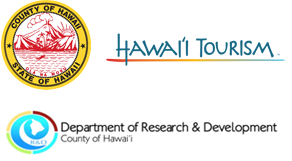From around the World, High School Students Gather in Hilo to Learn from Local Scientists and Engineers
‘Imiloa Astronomy Center of Hawaii hosts third annual Pacific Astronomy and Engineering Summit

Kai Kahele with the 2015 Pacific Astronomy and Engineering Summit
Hilo, HI (July 17, 2015)- Thirty-one students and teachers representing each of the Thirty Meter Telescope International Observatory partner countries gather in Hilo this weekend for an intensive five-day forum on astronomy and engineering. The United States is represented by eight students and three teachers from St. Joseph School, Kealakehe High School, and Kamehameha Schools-Hawai‘i. An additional 15 high school students and five teachers from Canada, China, India and Japan are also participating.
The third annual Pacific Astronomy and Engineering Summit (PAES) provides high schools students with a forum for in-depth learning and collaboration. Hosted by the ‘Imiloa Astronomy Center of Hawai‘i, the Summit is made possible through the support of the TMT International Observatory and the Mauna Kea Astronomy Outreach Committee, with cooperation from the Hawaii Space Grant Consortium and University of Hawai‘i at Hilo.
Worldwide, there is growing demand for workers trained in science, technology, engineering and math – commonly referred to as STEM. The Alliance for Science Technology Research in America estimates that by 2018, Hawai‘i alone will need to fill 29,000 STEM-related jobs. Expanding exposure to STEM programs and professionals is critical for preparing Hawai‘i’s youth for these opportunities.
The summit schedule will include “hands-on/minds-on” workshops and experiential learning on topics ranging from indigenous engineering, exploring optics, and the composition of meteorites, to finding exoplanets with digital cameras, making a telescope, and simple robotic programming. Students will have opportunities to interact with scientists and engineers, including many associated with astronomy on Maunakea, to exchange ideas and solutions that advance their shared interests in STEM disciplines.
“Science education and partnerships are critical to creating tomorrow’s researchers, educators, inventors, and technicians, and it is they who will continue to use science, technology, and culture to inspire the exploration of our Universe, the advancement of our society, and the preservation of our Earth for future generations,” said Henry T. Yang, chairman of the TMT International Observatory.
“In this age of globalization, technology allows us to communicate and collaborate across borders, and the experiences these students share over the next five days will result in friendships and working relationships that last for years to come,” he added.
Astronomers, engineers and distinguished community leaders will deliver keynote presentations through the week to inspire and encourage student participants to pursue their interest in STEM disciplines. Speakers will include:
- Kaiali‘i Kahele, executive director, Pa‘a Pono Miloli‘i
- Dr. Jim Kauahikaua, Hawai‘i Volcano Observatory
- Dr. Heather Kaluna, University of Hawai‘i Institute for Astronomy
- Mary Beth Laychak, Canada-France- Hawai‘i Telescope
- ‘Ahia Dye, ‘Imiloa Astronomy Center of Hawai‘i
- Geoffrey Marcy, professor of astronomy, University of California, Berkeley
- Chad Kālepa Baybayan, ‘Imiloa navigator-in-residence, navigator/captain Mālama Honua Worldwide Voyage. Each school team will be making a presentation and receiving professional feedback on a research project that they have undertaken on an aspect of astronomy or engineering. Student science presentation topics include:
- Moon Phases and Probability of Destructive Tsunami Activity
- The Nature and Motion of the Andromeda Galaxy´s Stellar Disk
- How early Polynesians used the Hawaiian Star Compass to Navigate
- Launching a Spacecraft within the Atmosphere using Helium Balloons
- Rock Climbing Robots
Rounding out the summit will be immersive experiences in ‘Imiloa’s Exhibit Hall and Planetarium, leadership training exercises, and off-site field trips for stargazing and to explore Hawai‘i Volcanoes National Park. The students will also be sharing cultural presentations on their home countries and cultures.
“The students involved in the summit all come from countries with rich histories in the advancement and appreciation of science,” said Ka’iu Kimura, executive director of the ‘Imiloa Astronomy Center of Hawai‘i. “Helping students appreciate the history and cultural context of the science they are learning deepens their insights and understanding.”
The attendee list for the 2015 summit includes Kehan Yang, a member of the Chinese delegation who was the winner of the TMT Engineering Challenge at the Intel International Science and Engineering Fair. Yang’s wall-climbing WiFi-based Reconnaissance Robot uses negative pressure absorption, four-wheel drive, and is controlled by a cell phone Java application, which transmits digital and video signals simultaneously to an embedded wireless module on the robot. The light robot materials were produced using 3D-printing technology. Another summit participant, a Kamehameha Schools student from Oʻahu, recently represented the state of Hawai‘i at the Intel International Science and Engineering Fair.
Modelled after the acclaimed Ritsumeikan Japan Super Science Fair and International Student Science Fair, PAES is designed not only to expand students’ learning opportunities, but also to foster future collaboration among student scientists. “International cooperation is really necessary for young scientists,” said Hiroshi Tanaka, Ritsumeikan High School principal, who first hosted the Japan Super Science Fair twelve years ago. “I believe participants broadened their horizons and constructed a global network.”
For more information, about the 2015 Pacific Astronomy and Engineering Summit, contact Margaret Shiba, Director of Institutional Advancement, ‘Imiloa Astronomy Center, mshiba@imiloahawaii.org or visit http://www.paes.hawaii-conference.com.




